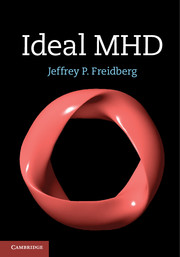Book contents
- Frontmatter
- Dedication
- Contents
- Preface
- Acknowledgements
- 1 Introduction
- 2 The ideal MHD model
- 3 General properties of ideal MHD
- 4 MHD equilibrium: general considerations
- 5 Equilibrium: one-dimensional configurations
- 6 Equilibrium: two-dimensional configurations
- 7 Equilibrium: three-dimensional configurations
- 8 MHD stability – general considerations
- 9 Alternate MHD models
- 10 MHD stability comparison theorems
- 11 Stability: one-dimensional configurations
- 12 Stability: multi-dimensional configurations
- Appendix A Heuristic derivation of the kinetic equation
- Appendix B The Braginskii transport coefficients
- Appendix C Time derivatives in moving plasmas
- Appendix D The curvature vector
- Appendix E Overlap limit of the high β and Greene–Johnson stellarator models
- Appendix F General form for q(ψ)
- Appendix G Natural boundary conditions
- Appendix H Upper and lower bounds on δQKIN
- Index
- References
12 - Stability: multi-dimensional configurations
Published online by Cambridge University Press: 05 July 2014
- Frontmatter
- Dedication
- Contents
- Preface
- Acknowledgements
- 1 Introduction
- 2 The ideal MHD model
- 3 General properties of ideal MHD
- 4 MHD equilibrium: general considerations
- 5 Equilibrium: one-dimensional configurations
- 6 Equilibrium: two-dimensional configurations
- 7 Equilibrium: three-dimensional configurations
- 8 MHD stability – general considerations
- 9 Alternate MHD models
- 10 MHD stability comparison theorems
- 11 Stability: one-dimensional configurations
- 12 Stability: multi-dimensional configurations
- Appendix A Heuristic derivation of the kinetic equation
- Appendix B The Braginskii transport coefficients
- Appendix C Time derivatives in moving plasmas
- Appendix D The curvature vector
- Appendix E Overlap limit of the high β and Greene–Johnson stellarator models
- Appendix F General form for q(ψ)
- Appendix G Natural boundary conditions
- Appendix H Upper and lower bounds on δQKIN
- Index
- References
Summary
Introduction
Chapter 12 is concerned with the MHD stability of toroidal systems, specifically tokamaks and stellarators. As might be expected the complexities associated with multidimensional systems make analysis quite difficult. Consequently, in practice stability results are often obtained numerically. There are, however, a variety of simple models which do provide physical insight into qualitative geometric features that lead to favorable and unfavorable stability behavior. This chapter describes several of these simple models plus summarizes several of the major numerical studies.
The discussion begins with a general analysis of ballooning modes. These are radially localized modes with short perpendicular wavelengths and long parallel wavelengths. They arise because most toroidal configurations have magnetic geometries with alternating regions of favorable and unfavorable curvature. The most unstable perturbations are those whose amplitude “balloons” out in the region of unfavorable curvature. The modes are important because they set one limit on the maximum stable β in toroidal configurations.
- Type
- Chapter
- Information
- Ideal MHD , pp. 570 - 677Publisher: Cambridge University PressPrint publication year: 2014



